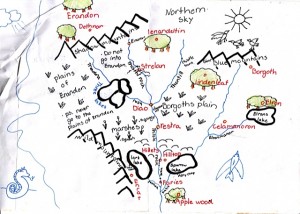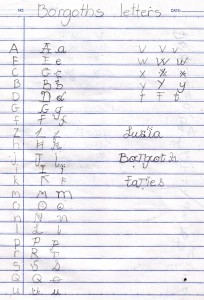Two days ago, our family listened to a sermon about “The Monster of the Deep” as part of a series called “Shipwrecked” by Temple Bible Church in the USA. In this sermon, the speaker, Gary DeSalvo, referred to a quote by the “great theologian” from the Hobbit, Bilbo Baggins, who said, “It’s never wise to leave a live dragon out of your calculations, especially if it lives close by.” We need to be aware and we need to be wary of the “Monster of the Deep”.
Two days ago, lovers of literature commemorated the death of JRR Tolkien who was born on 3 January 1892 in Bloemfontein in the Orange Free State (now Free State Province) in South Africa and died on 2 September 1973. Tolkien was perhaps best known as the author of the Lord of the Rings trilogy in which Bilbo Baggins shares some of his wisdom with us. Those of you who are familiar with the rich complexities of Tolkien’s Middle Earth where the trilogy was set, would know that he invented extensive vocabulary, grammar and syntax to create Elvish languages with intricate scripts that are spoken throughout the tale, along with the languages of the Dwarves and the Men.
Inspired by Tolkien, our daughter Lucia began to create her own imaginative “Middle Earth” couple years ago, with maps such as this script of “Borgoth’s alphabet” below left and the “Map of Elthnel – for Borgoth” below right:
Tolkien loved the English language, but he was also a philologist and a student of a combination of literary studies, history and linguistics. He learned Latin, Greek, Gothic and Finnish, to name just a few. Many words in his fictional languages have been influenced by his fascination with the Finnish language. But something that not too many people are aware of, is that Tolkien also put his hand to the translation of the Scriptures. Tolkien was invited to contribute in the area of Bible translation. His translation of the book of Jonah as part of the Jerusalem Bible brought a distinct literary quality to the translation! What a remarkable man he was, and what a legacy he left in both the domains of fiction and Bible translation.
Back to the “Monster of the Deep”. Not too long ago, we stopped at a small village a few hours drive away. While Hans and the older children were out and about, Patricia watched Anna-Sophia who was not even one year old. Suddenly she heard shouting in one of the houses close by. Shortly thereafter, a whole extended family came running out of their house. Thinking it might be a snake, Patricia walked closer, only to be told that one of the elderly men was possessed by an evil spirit. Patricia offered to pray for this man in the name of Jesus, but the family declined. Yet, they were terrified. We were reminded that Satan – the “Monster of the Deep”, our “enemy the devil prowls around like a roaring lion looking for someone to devour” (I Pet 5:8). Therefore, we need to resist him and stand firm in the faith, for “our struggle is not against flesh and blood, but against … the powers of this dark world and against the spiritual forces of evil in the heavenly realms.” (Phil 6:12).
We need to be alert, but not fearful. We will be tested, but we have God’s promises that He will never leave us nor forsake us. Job was a righteous man – we read that “he was blameless an upright; he feared God and shunned evil” (Job 1:1). Yet, he was not immune to temptation or even attack from Satan, who is described as “roaming through the earth and going back and forth in it” (Job 2:3). But Satan knew that he could do nothing to Job against the will of God, since God “placed a hedge around him and his household and everything he has.. and blessed the work of his hands, so that his flock and herds are spread throughout the land.” (Job 1:10)
We are in a spiritual battle, but we know that the war has been won. Let us stand firm against the “Monster of the Deep” and trust God to bless the work of our hands.



I’ve gone back and forth through Bibles, using moltsy the ESV and NIV in the past. I gave up using ESV because it was so choppy to read through, even though it was good for study. Readability and accuracy are both important to me. I still use the NIV a lot (a NIV/ Message parallel for reading), but it’s too familiar to me. I tend to gloss over verses a lot on accident, and the translation can be kind of generic sometimes.I’ve landed on the HCSB. They’ve marketed this Bible moltsy as specialty Bibles (the soldier’s Bible etc.) but it’s an amazing version. It uses an “optimal equivalence” approach which uses both thought-for-thought and word-for-word depending on which they felt best portrayed the text. It uses words like “Messiah” instead of “Christ” and it just makes so much sense reading it. It is rich in language and very understandable.Here at SIBI, I’ve heard teachers say, “the real word should be ___ and I just wish a translation said it.” A lot of times the HCSB does! But they always forget the version lol. Anyway, I just bought a bigger version of it and plan on using it as my main version now.
Maybe you are aware that there has been an update of the NIV® for 2011. The chief goal of every revision to the NIV® text is to bring the translation into line both with contemporary biblical scholarship and with shifts in English idiom and usage. In 1984, various corrections and revisions to the NIV® text were made. A lengthy revision process was completed in 2005, resulting in the separately published Today’s New International Version (TNIV®). This updated NIV® builds on both the original NIV® and the TNIV® and represents the latest effort of the Committee on Bible Translation (CBT) to articulate God’s unchanging Word in the way the original authors might have said it if they had been speaking in English to the global English-speaking audience today.
My in-laws bought my wife and me mahticng ESV study Bibles for Christmas and we have been reading/studying from it primarily this year. Loving it! I grew up with King James, I read it in my youth,I read it in my Sunday school,It’s how I learned the truth (bonus points for anyone who can name that tune)But then I got into Bible bowl at age 12 or so and discovered NIV. Spent years and years there, then I realized I was allowed to read other translations. My wife just bought me a pocket-sized Holman Christian Standard Bible a week ago Saturday and I’m loving it, too!So now my favs are (in no particular order) ESV, NLT, NASB, NCV, HCSB, and the old standby, Mr NIV (I actually got to where I didn’t care at all for the NIV, but I think I was just burned out on it). I also dig the Message. I’ll have to try God’s Word version.Great post. May I steal your idea, Trey?
Hi Trey, my sense is that we can never get enough of God’s Word – irrespective of what translation we read. So, I’m encouraged to see that you are trying out different translations! Keep reading and growing. And go ahead: you may use anything in this post as you like.
This is really cool blog, but I have a few suggestions. Your blog isnt fully SEO optimized, and that means that you have to work harder to get #1 place on google , and its really hard you know. If you get 1st spot on google it will skyrocket your incomes, it happened with me some time ago, when i was noob and 1 guy helped me with on page optimization, and yeah, i went #1 and i was earning 4x more then before. Here is cool on-page SEO plugin – http://bit.ly/xqj97z – it will save much time for you. Good luck and have a nice day sir !
Your work is very appreciated by me, I always read your posts.
Hi, i have reading out and i will definitely bookmarrk your site, just wanted to say i liked this article.